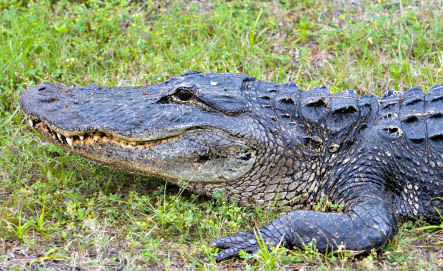Alligators Swimming Secrets
Alligators are indigenous to two locations. The southern
United States and in China near the basin of the Yangtze River are the two
places you may run into an gator. Although similar, there are some distinct
differences in the two specimens.
The American gator is larger than the Chinese gator. The American gator can reach a length of 19 feet and a weight of 600 pounds. The Chinese gator grows to six feet and weighs a lot less than its American
counterpart. Both are prolific swimmers and prefer fresh water to salt water.
There are occasions when they will be found in brackish water, but seldom in
the salt water of the oceans. The Chinese gator differs from the American gator in another way. While the underside of the American gator is smooth,
the Chinese alligator has a scaled underside.

Alligators swim by using their lengthy
tails to propel them through the water. The tail length is equal to the length
of the body. The webbed feet are used to some degree, but the tail is the
primary propellant. The tail of the alligator has other functions. The tail is
a strong weapon against predators or potential food. This natural swimmer is known to be found throughout
the state of Florida as well as other southern states. If there is a pond,
stream or lake, there is a potential for gator population.
When the gator comes on land, they are capable of a flat-footed, rapid
burst of speed. The bursts are short, and very fast. During the spring, they
are on land to build their nests and lay their eggs. The nest is very large. It
can measure 3 ft. tall and 6 ft. wide. An gator can typically lay up to
fifty eggs. The warmth of the materials in the nest helps the eggs to hatch.
The weight of the gator would crush the eggs if she laid on them. She will
help the babies out of the eggs and tend to their needs for at least one year.
This includes the art of becoming a strong, natural
swimmer.
Baby gators will live on small fish,
insects and anything that will fit into their mouth - all of which contains the micronutrients they need. As they mature, the food
will get bigger. When the gators are
fully grown, they will consume anything that they can swallow without chewing.
They do not routinely kill with their mouths. Their tail is a much stronger
weapon. In the event of a broken tooth, the gator will grow another one.
With human habitation taking over much of their natural habitat, gators have been known to show up in many
backyards in the southern states.
Although once endangered, the American gators
were saved from extinction by conscientious citizens. No longer are they hunted
for their hides in the United States. The Chinese gators
are currently endangered, and efforts are being made to protect these animals.
They have survived since the age of dinosaurs and are a member of the dinosaur
family. The perils they faced from natural occurrences were not as damaging as
the things that human beings have done to them.
One can learn how to swim better by watching these sea creatures. Their tails move their chi energy while their jaw size determines their diet.
back to the top of alligators page
from alligators page to ocean life page
Today's Daily Swimming Workout:
Warm up: 500 freestyle, 100 breaststroke kick no board, 200 Individual Medley, 100 kick-on-back butterfly with fins, 100 side kick freestyle with fins
6 x 150 as repeating no rest with fins: 25 butterfly kick butterfly, 75 butterfly, 50 freestyle; 25 backstroke kick, 75 backstroke, 50 freestyle; 25 breaststroke kick, 75 breaststroke, 50 freestyle; repeat
100 Individual Medley
Pull with hand paddles: 4 x (100 breaststroke + 200 freestyle)
Fins on: 2 x (100 backstroke + 200 freestyle)
10 x 50 alternating backstroke and freestyle
Warm-down: 200 freestyle
Total: 4500 meters or yards depending on pool size








